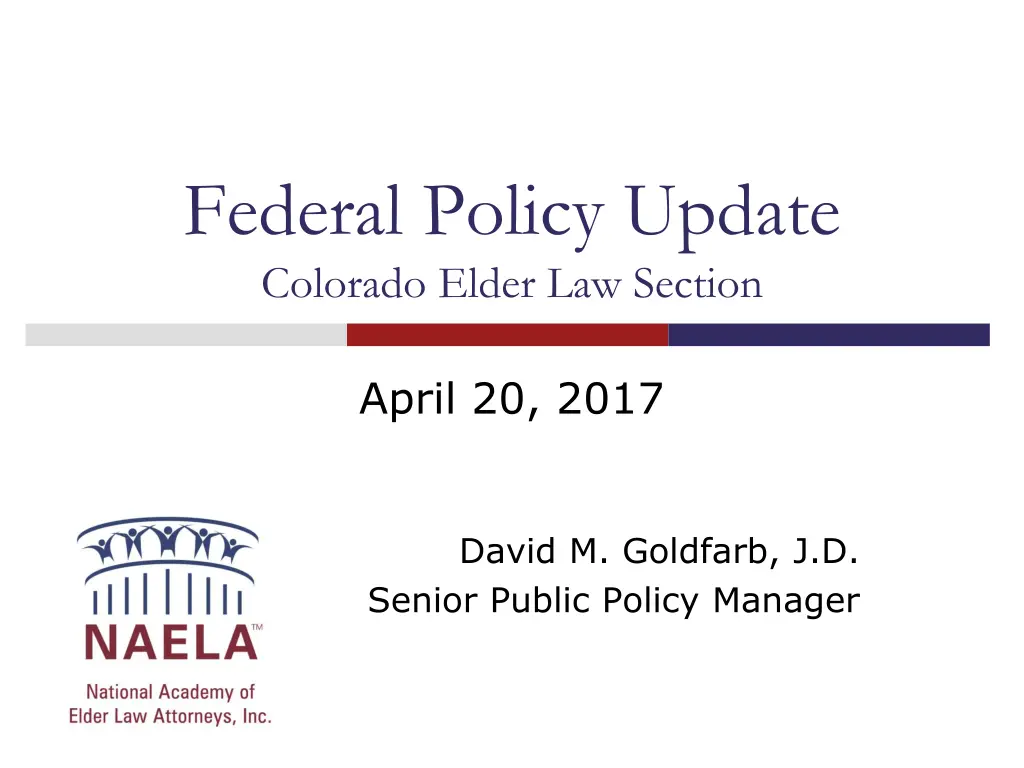
Update on Colorado Elder Law: AHCA Impact & Key Medicaid Reforms
Stay informed about the latest developments in Colorado elder law with a focus on the American Health Care Act (AHCA), its effects on Medicaid, key tax cuts, and structural reforms. Understand the changes in healthcare policy and their implications for seniors and their families in Colorado.
Download Presentation

Please find below an Image/Link to download the presentation.
The content on the website is provided AS IS for your information and personal use only. It may not be sold, licensed, or shared on other websites without obtaining consent from the author. If you encounter any issues during the download, it is possible that the publisher has removed the file from their server.
You are allowed to download the files provided on this website for personal or commercial use, subject to the condition that they are used lawfully. All files are the property of their respective owners.
The content on the website is provided AS IS for your information and personal use only. It may not be sold, licensed, or shared on other websites without obtaining consent from the author.
E N D
Presentation Transcript
Federal Policy Update Colorado Elder Law Section April 20, 2017 David M. Goldfarb, J.D. Senior Public Policy Manager
Contents American Health Care Act I. II. Targeted Medicaid Reform III. 1115 Waivers IV. Other items (tax, SS, Medicare, ect.) V. Discussion
American Health Care Act (AHCA) AHCA contained Health insurance reform Tax cuts Per-capita cap Medicaid with block grant option Ended Medicaid expansion Targeted Medicaid Changes Congressional Budget Office (CBO) analysis 24 million would lose coverage over ten years $880 billion dollar cut to Medicaid Tax cuts about equal to Medicaid cuts
AHCA: Health Insurance Reform Continuous coverage requirement Age-ratio increase with state flexibility Tax support based on age with income phase-out $100bn fund for states to use for reinsurance and other purposes No individual or employer mandates Actuarial value gone Essential Health Benefits up to states
Key Tax Cuts Medical Expense Deduction. Reduces the qualifying adjusted gross income threshold from 10 percent to 5.8 percent. Deduction was 7.5 percent pre-ACA. Withdrawals from Health Savings Accounts: Lowers non- medical expense withdrawal penalty from 20 percent to 10 percent the amount before the 2010 law was passed. Ends limits on Flexible Spending Accounts: The ACA set a $2,500 cap, adjusted for inflation. The legislation would lift the cap. End of Medicare Taxes for wealthy: individuals earning more than $200,000 or $250,000 for couples pay a surtax of 0.9 percent. Net investment tax of 3.8% above MAGI 200k/250k.
AHCA: Medicaid Reform Current system Based on a state-federal matching rate (FMAP). Range varies from 1 extra dollar per dollar spent to 3 extra dollars per dollar spent. Colorado is 1:1
AHCA: Medicaid Structural Reform Per Capita Cap Overview Caps federal contribution at a fixed dollar amount per beneficiary based on FY 2016 numbers by category. Elderly and Disabled Categories after amended would grow at medical inflation plus one percent; Other populations at medical inflation. Block grant option only for non-disabled adults and children at inflation.
AHCA: Medicaid Structural Reform Per Capita Cap Mechanics Calculation run, essentially: $ per beneficiary * # of beneficiaries= total allowable federal contribution. E.,g: 5ths per beneficiary * 10ths beneficiaries= 50 million dollars federal cap State spends using current FMAP. Year1: spends 50 million gets 50 million If state exceeds cap: Feds recoup payments on a quarterly basis following year Year 1: 55 million + 55 million= 110 million; year 2= 55 million + 45 million (55 million minus 10 million); If state spends under cap: no savings Year 1: 45 million + 45 million= 90 million. Year 2: No free 5 million extra.
Per-Capita Cap Concerns Change in state financial incentives Cut in services and quality Medicaid is mostly optional Mandatory population: SSI Mandatory NH vs. Optional HCBS: Optional Medically needy pathway options Eligibility changes inevitable Easily dial-able. Doesn t address demographic shifts
Lotto winnings under MAGI Count certain lump-sum distributions as income over time for MAGI Medicaid Proposal has gotten refined over time, AHCA just lotto winnings and inheritances. $80,000 threshold before application. Amortized at 10,000 a month thereafter.
CALM Act of a community spouse annuity made available to the institutionalized spouse Includes non-IRA retirement account annuitization within 5 year look back. Approved by subcommittee, not included in AHCA
CALM Act Cont. Concerns Overbroad: includes retirement accounts Overbroad: hurts working/middle class not just high dollar annuities. Incentivizes divorce. Women most harmed.
End option for home equity limits Ends option for a state to expand home equity limit for single individuals above 560k up to 840k (inflation adj.) Also a bill- H.R. 1082, Medicaid Home Improvement Act. Issues: No guarantee of reverse mtg/line of credit; could cause forced sale; If institutionalized: in some states becomes an available resource or in others family must maintain and deal with potential estate recovery; and Counteracts HCBS HCBS is cheaper because it does not pay for room and board. Liquidation means no home to come back too if institutionalized.
End of 3 month retroactive coverage Moved three month retroactive eligibility only to month of application. Also a bill- H.R. 180. Lose-Lose for Providers and Families: Providers don t get paid. Families could get sued or not admit family member at appropriate time without Medicaid guarantee.
Community First Choice Affordable Care Act created Community First Choice (CFC), a state plan option that provides personal attendant services without a waitlist. States got 6% FMAP boost in exchange. Low income threshold (150% SSI) AHCA sought to end 6% FMAP, potentially ending CFC as a viable option.
Money Follows the Person Demo that: Supports Medicaid enrollees who want to transition from nursing facilities back to community-based settings; Helps states develop infrastructure to promote and enhance access to HCBS. Expired last year (some funds remain). Colorado Choice Transitions (CCT)
Mar. 14 Price-Verma Letter Ushering in new era where states have more freedom to design plans State plan amendments- more fast-tracking and approval of demos done in another state and review MCO regulations HCBS settings- allow more time and more state involvement in compliance Wyden/Pallone raise concern about use of 1115 for work-requirements, cost-sharing, and other issues for NDE beneficiaries
1115 Waivers Basics Negotiated with CMS Notice and comment requirements Experimental, pilot, or demonstration project, meaning a state must be using the authority to test some hypothesis Likely to assist in promoting the objectives of the Medicaid program. Can waive Medicaid requirements under 42 U.S.C 1396a Budget neutral comprehensive or narrow
MEDICARE, SOCIAL SECURITY, AND TAXATION
Medicare Big Medicare reforms not presently on agenda. Chronic Care work in Senate Finance Committee Working to end observation status. Labeling prevents Medicare Part B SNF coverage Therapy Cap exception expires Dec. 31, 2017. Limits: Physical and Speech combined $1940.00; Occupational $1940.00 Automatic exception when beneficiary requires continued skilled therapy to achieve their prior functional status or maximum expected functional status within a reasonable amount of time Exception for after $3700, subject to RAC review
Social Security Good news: SS Retirement/SSDI cannot be done via reconciliation per rules! Bad news: SSI can be reformed via reconciliation SSI for Children in Speaker Ryan s Better Way Expresses concern about number of Children on SSI The individuals stay on SSI on average 26.7 years 30 percent of older teens on SSI dropout of H.S. Solution: end or limit cash assistance and replace with services, such as mental or physical therapies or SPED services in school. Rep Payee Issues: Bipartisan interest, hearing held on Feb. 7, NAELA participating in CCD recommendations.
Speaker Ryans Tax Proposal Move towards elimination of deductions No more AMT lower rates on pass through and small businesses (topped at 25% bracket) Capital gains get deducted by 50%, so taxed at either 6%, 12.5%, or 16.5% Consolidate standard deduction, personal exemptions, and child tax credit Consolidate education benefits (529, ect.) End estate and generation skipping taxes
Tax Reform: Other Issues ABLE Act Improvements 529 Rollover Increase by FPL ($11,400) if working Age increase to 46 Elder care/ child care tax deductions/credits (Trump stated priority) AHCA demise makes tax reform harder Revenue-neutral or not? What can change via reconciliation? Disagreement on boarder adjustment tax.
Other Items Deconstruction of Admin state and legal reforms. Discretionary items, such as Senior Health Insurance Program (SHIP). CHIP Expires Sept. 30, 2017 Could be vehicle for Medicaid eligibility cuts










